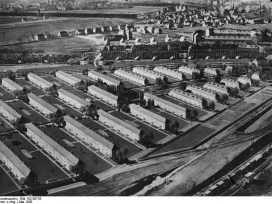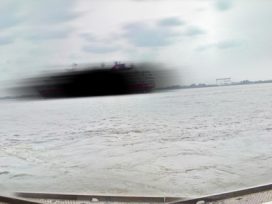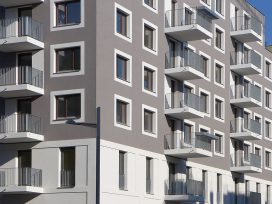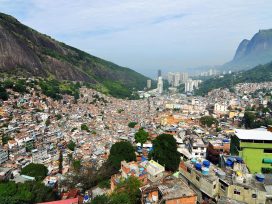In a world in flux, connection hubs guarantee the relationships between places and types of mobility. Connection hubs cannot be conceived solely from the point of view of transportation, since they establish urban “spheres” around them, with different speeds as well as qualities of transportation and types of service. They therefore constitute transit spaces that are more or less adapted for hypermobility: these spatial switches are also “selectors”, secure doors allowing for various degrees of openness, ranging from free passage to checkpoint.
Airports are often taken as the prime example of the connection hub, since they are used by international, mobile populations for whom moving between airports is one and the same thing as moving between cities. But the airport hub has a dual function, characterized by suspension: it combines a well-connected urban centre with a weightless transit space and a number of enclosed spaces, rooms that are locked and inaccessible, where refugees and illegal immigrants are rounded up and detained in cells, in suspense, or awaiting deportation to wherever they set off from. The airport is both open and closed, peaceful and prisonlike; it is a junction that must prioritize the serenity of the passenger in transit as well as checking the identity of all who wish to enter. This is the highly selective task of these sites of juncture; as Marc Desportes puts it, “stations, airports, motorway hubs […] play a primordial role. It is from these nodes that we build our networks, that we can move from one to the next, or leave them behind. […] The use made of these points of interchange thus resembles an ongoing process of encoding and decoding: encoding in order to match the system being used, decoding in order to return to the everyday space.” Connection hubs therefore tend to be bidirectional: they allow access, but not to everyone. The more the connection hub is focused on linking to the globalized flows required by hypermobility, the more controlled and selective it is.
A connection hub is associated with a certain speed but also with a capacity for control, whether it be customs checks at an international airport to the security checks requiring passengers in transit to pass through gates. The modes of control are specific to the nature of the connection hubs, which in turn are shaped by their particular speeds: hubs that are closely linked to international networks require more checks; those that are less connected merely use control as a means of exclusion. While the connection hub both inhales and exhales, absorbs and expels, the connected territories are not all equivalent; as a result, the “zones of connection” are more or less selective.

Understanding the workings of urban space today requires acknowledging that the connection hub, the hub of our connected society, constrains access and connectivity. A connection hub is not merely a platform; its role is also to control migratory movements and access levels. Connection and access control are hence inseparable: Sangatte and Tangiers show that migrants move via ports, ships’ holds and trucks. There is also a “multi-speed urbanism” arising from the relation between the types of connection hub and their speed. It is possible to observe a growing gulf between a hyper-urbanism linked into globalized flows and a hypo-urbanism that tries to revert to a more local space through the use of the car. Even so, these two reticular urbanisms share a quality of decontextualization. Just as connection goes hand in hand with access and therefore with selection, so interconnection entails decontextualization.
Velocity and just-in-time flow
If the port connection hub – which dominates international commercial exchange – is integral to maritime transport, it is also tied to the status today accorded to the maritime shoreline in countries lucky enough to have borders on the sea. Nowadays, the maritime and the liquid have the edge over the terrestrial and the solid, both in reality and in representations; the coastal world now exerts such an attraction that two thirds of the planet’s urban populations live less than 100 km from the coastal borders.
Notwithstanding the pull of the littoral, speed is the single most important factor in our understanding of the role played by port connection hubs. Contrary to initial assumptions, the speed that characterizes almost all commercial traffic favours maritime commerce, which is far from being the most rapid. If the speed of commercial transport ships on the open sea (from the cargo ship to the supertanker) is very much less than that of the aeroplane, it nevertheless favours “just-in-time” (JIT) maritime circulation, a method that entails the least conflict in stocking/destocking capacity. This makes maritime speed the most efficient of all, with “JIT flow, zero storage”. The exo-urbanism that is developing on the coast is part of the world of the harbour, characterized by continual flow and low levels of storage, made possible by container technology. As Paul Virilio writes, “we are moving from a revolution in transport to one in loading, given the endless growth in the volume of goods. There has been a revolution among the large carriers; this logistical revolution of containers is bringing about another global reality, and one which is often out of sight.” Out of sight because mobility depends on wherever there is a “break in the cargo chain” – on a multimodal platform that conjugates the maritime, the landed, the railway and the airborne to maximum effectiveness.
However slow it may be, maritime speed rivals faster speeds due, first of all, to the recent and rapid construction of gigantic, purpose-built ports (Singapore; Tangiers-Med), without which “JIT flow, zero storage” would remain hypothetical. Specific territories that are foreign to the port culture of the industrial and pre-industrial eras depend on “the universalization of a means of transport”, the container, which is doubly appropriate to its speed, and has come to symbolize the globalization of commerce. The slogan of the era, “JIT flow, zero storage”, belongs to the port, the most decontextualized of connection hubs because the most deterritorialized, multimodal and containerized. These transformations are just as perceptible in emerging countries’ newly-built ports as they are in the transferral of port zones to some distance from traditional ports (Le Havre, Saint-Nazaire, Tangiers). In the case of port connection hubs, four factors therefore demand attention: the phenomenon of timed flow; the development of vast, global ports; the re-territorialization of ports, which goes hand in hand with decontextualization; and the decisive role of the container, which permits zero storage.

“JIT flow, zero storage” means traffic that is almost uninterrupted, with the shortest possible time for loading and unloading, so as to minimize outlay on mooring costs. In some cases, JIT flow requires that loading takes place at some distance from the on-land port zone; giant petrol tankers, for example, unload to offshore platforms. Automated by means of computerized trolleys, the giant port operates in zones that are closed to the public (as used to be the case for military ports, from Toulon to Alexandria). These are securitized zones that operate on a 24-hour no-access policy. While the aeroplane’s speed once put passenger navigation at a disadvantage, today’s pleasure cruisers are today seeing an increase in uptake, while the primary speed of commercial exchange remains the maritime. The statistics for maritime freight speak for themselves: 95 per cent of the volume of global commercial exchange takes place via the sea, a volume that has multiplied over 10 times since the 1950s. This is no accident: the liquid world requires fluidity and avoids the obstacles presented by the surfaces of solid ground (hills, mountains, faults, rivers). At sea, it is possible to forge ahead despite storms, hazards and pirates.
While maritime commerce has been heavily affected by the financial crisis of 2008, it remains the basis for the development of the enormous shipyards that have become integral to many ports, primarily in the Far East (South Korea, China, Japan) and in giant ports such as Singapore, the largest in the world. In his book The Box, Marc Levinson writes that “before the opening of the new terminal in 1971, the Singapore Port Authority was predicting a circulation of 190,000 containers after ten years in operation, while in fact they totalled one million by 1982. By 1986, Singapore was channelling heavier traffic than all the French ports put together. By 1996, more containers were coming through Singapore than through Japan. In 2005, the city became the premier port in the world for diverse freight, overtaking Hong Kong, while 5000 international companies were using this island state as a centre for storage and distribution – proof, if ever there could be, of the power of the transport industry to reshape the flow of commerce.” These days, on the Europe-Asia axis, eight container ships with 14,000 containers and 200 men on board may carry as much as 140 cargo ships with 6500 sailors used to manage in the 1960s.

Today, the interconnected port is also a decontextualized territory at the end of a process that began in the industrial era, when the seafaring world was already losing ground – as we can see from the photography, films and painting of the time – to be supplanted by the transporter bridge and giant steel-framed cranes. This decontextualization, until recently seen only in military ports (Alexandria, or San Diego), promotes industrial objectives at the expense of residential port settlements (Marseille, Bordeaux, Le Havre, Brest), contributing to the reconfiguration of coastlines by setting them apart from continental territories and landlocked cities. “Apart from strong counter-examples such as Berlin, Mexico City, Moscow and Beijing, global cities which have no sea access,” writes Pierre Gras, “it is the ‘global cities’ of the ports that benefit most from the globalization of commerce both in the Northern and the Southern hemispheres.”
This is why great non-maritime conurbations tend to seek access to the sea, as demonstrated by the proliferation of competing ports and above all by the creation of “duopoles” linking a coastal port and an inland metropolis. There are many examples of this: Tianjin/Beijing and Hong Kong/Shenzen in China; Santos/Sao Paulo in Brazil. But the success of each pairing depends on the duopole’s success in creating a direct relationship between the port terminal and the inland metropolis by means of a railway and bus network. In the case of the Santos/Sao Paulo duopole, two cities separated by the 60 km breadth of the Sierra do Mar, the aim is to handle transport of 230 million tonnes of goods and 9 million TEUs (twenty-foot equivalent units) in the next ten years. However Sao Paulo is in an uncertain position, being neither precisely on the sea, nor exactly landlocked. In the case of the Tianjin/Beijing duopole, two cities 200 km apart, which aims for 10 million TEUs by 2015, problems lie in the uncoupling of the port from the city and the absence of any concern for the environment.
By way of comparison, the historic old city of Shanghai is seeking to forge a link between itself and Pudong, a new town and port terminal (the aim being to reach a capacity of 10 million 20-foot containers by 2018) by building three polders and a 31 km bridge. Incheon in South Korea is another example of a giant port in an emerging country: intended to rival the port cities of coastal China and Japan, this connection hub (60 million people, a town focused on high-end technologies, container docks anticipating 8 million TEUs between now and 2015, over a surface area of 210 km squared) is keen to ensure an “ecological” urban continuum between the brand-new port, built upon three polders, and Seoul, the capital located inland. Nevertheless, the ecological challenge seems hardly to have been addressed. The port of Salalah to the South of the Arabian Peninsula provides a counter-example: located in the South and in the midst of the Oman desert, this harbour city offers a maritime staging post on the Dubai route and is not connected to any larger town; it forms an offshore port, with 200,000 inhabitants.
The geography of containerization
The container plays a decisive role, having altered the entire transport system, and is, in a way, a multi-modal platform: the “box” can be adapted for a range of different kinds of transport, which enables continuity in flow management and significant cost savings. The container’s mobility is international, since it is usable and effective in both maritime and railway freight, and can also be carried by trucks. This capacity for permanent transit has led to misperceptions among the involved parties: governments as well as markets, trade unions as well as businesses. For example, in the 1960s the directors of the port of New York failed to anticipate the multimodal nature of the container, which establishes a continuous, robotized chain, and instead tended to see it as a competitor.
In the case of port connection hubs, containers are not only symbols but a reality, matching the slogan “JIT flow, zero storage” to the letter. The disconnection from old port towns hence goes hand in hand with the omnipresence of the container. Ports and their container storage wharves are becoming increasingly dominant, intruding even on the borders of Le Havre town, for example. Indeed, maritime speed under timed flow can function because the container is used internationally; it is nothing more than a resilient box that can be used for any purpose, however that constitutes “a change as important and spectacular as the move from sail-power to steam”.
Today, there are around 3000 ships in operation capable of transporting an average of 3-4000 containers and, in the case of about 30 of them, up to as much as 10,000. The “boxes”, in the parlance of the ports, are everywhere: there are around fifteen million of them in circulation, transporting 80 per cent of the eight billion tonnes of merchandise that travels by water every year. Growth continues, despite economic crisis, following the discovery that some ships are able to carry almost 18,000 containers into the Korean ports, the biggest of which can handle up to 12,000 TEUs. Petrol tankers have ever more remarkable capacities, as demonstrated by the VLCC (“very large crude carrier”). Sixty metres wide and 333 metres long, the VLCC has a capacity of 2 million barrels, equivalent to 1 million car petrol tanks or 2.6 million full diesel tanks (given a tank capacity of 60 litres). The largest of the container-carriers, the Maersk Triple-E Class, which will come into use in 2013, will be 400 metres long and able to carry 18,000 boxes, corresponding to the height of a 24-storey tower-block, a cargo whose value could be as much as 1.5 billion dollars (as much as the GDP of Burundi, or 9000 articulated lorries).
The globalized geography of containerization comes with another, stranger phenomenon: the aestheticization of the container. At first, the fascination exercised by the box appeared to be zero, since it has none of the elements traditionally associated with the marine world. But an aesthetic revolution has intervened, making the container into a design object prized by artists and architects, who use it as a fixed object that can be inhabited under minimal and economical conditions. Shaped like a cabin, the box is the building block for clusters and montages of all kinds, to be used as student accommodation or hide-outs for illegal immigrants and the homeless. A matrix of intermodality, it can be fixed, immobilized and turned into a dwelling or place of refuge. As Virilio writes, the container’s final role is as a terminal: “The bedroom is the ultimate box, while the high-speed terminal is just as much a container. The container is an architectural figure of the box. It becomes the interconnected locus solus.”
The container, whose principal purpose remains moving commercial freight, is caught between two directly opposed tendencies: it oscillates between offering apparent luxury and being a hide-out; it can just as easily function as a habitable box (luxurious or not) and as a secret place of refuge. Michael Winterbottom’s film In This World (2002) recounts the journey of illegal immigrants sealed in a container that travels from a lorry to a ship’s hold, from one frontier on to the next. When containers no longer function for the transport of goods, these symbols of globalization can end up in conflict zones, where they become groceries, fashion boutiques, even garages. Examples of recycled containers are numerous: a showroom, a boutique made up of a stack of containers. At the London docklands, 20 containers are arranged over four storeys to form 15 workshops and/or homes. Amsterdam and Le Havre have turned to containers as the basic unit for general accommodation (the Keetwonen campus at Amsterdam) or student housing (boxes stacked up to four floors at Le Havre). Omnipresent and the object of an aesthetic cult, the container remains ambivalent, standing both for extreme mobility and as a secure space of refuge or intimacy (a detention centre, prison cells, student halls). As if inevitably, the limitlessness of timed-flow tips over into its opposite – into inspection and containment.
These new ports follow the advent of brand-new maritime routes. If there is a technology of containerization, then there is also a geography of containerization. This renders visible the fluctuating nature of the great maritime routes, where the more recent marginalize the older ones. As the geographer Antoine Frémont argues, “the primary maritime routes linking the three great economic hubs on a global scale in fact account for 80 per cent of traffic. The principal artery remains the route linking the North Atlantic to East Asia, with its unequal flow, representative of the considerable commercial influence of the United States. But the sea route between East Asia and Europe has gained importance (Le Havre: 2.3 million containers every year). This route begins in the heart of Asia, going from the Japanese ports to Singapore, via Busan, Shanghai or Hong Kong, and appears increasingly like an endless highway between East and West.”

These maritime routes enforce the point that harbour connections form a stratified liquid network that is not anarchically open to any or all sea winds. The emergence of the Gulf ports in Mediterranean space – in particular Dubai, but also Khor Fakkan (United Arab Emirates) and Salalah (between the gulfs of Oman and Aden) are already turning the landscape of the global maritime economy upside down. Tangiers Med, to the West of the city of Tangiers and opposite Gibraltar, which links the Rabat/Casablanca/Algesiras/Barcelona hub to the Middle East and Asia, is weakening European ports, especially French ones. Le Havre, which is struggling in the face of unfavourable competition with the Randstad, will also face the opening of a new route: the infamous North-West passage. If the distance between Rotterdam and Asia represents 24,000 km via the Panama Canal and 21,000 km by the Suez Canal, it will be 15,500 km once boats are able to go past the South coast of Greenland, Aalsmeer and the Bering Strait, a route that could soon open up due to the melting of Arctic ice. The port of Le Havre will thus be doubly circumvented to the North and the South. But maritime routes also present technical challenges to the giant container-carriers: the shipping term “Malaccamax” to denote the largest size of ship capable of fitting through the 25-metres deep Strait of Malacca (a busy sea corridor between Malaysia and Indonesia) refers to the potential dimensions of these ships. How can a giant ship navigate this narrow maritime passage, so dear to Joseph Conrad, without incurring risks? The answer lies in the proportions of the Malaccamax, which must be no more than 402 metres long by 58 metres wide, with a submerged hull 20 metres below the flotation line.
The offshore port project in the Scapa Flow, in the Orkney Islands off the northern Scottish coast, points to the fact that today’s newly emerging ports require favourable positioning from both geographical and political points of view. While the Colombian port of Buenaventura, situated west of the Pacific town of Cali, has largely failed to adapt to this new port culture, rivalry between Antwerp/Rotterdam and Le Havre is clearly established. The latter has become the prime example of a “great port” to be rebuilt in order to guarantee the future of Greater Paris. Alongside these new globalized routes, there is a new interest in bringing back into service long disused, navigable waterways that extend inland and that could reduce the load carried by lorries. This is the case for the French Voies Navigables, where the aim is to double their share of river freight (56.1 million tonnes of merchandise were carried by river freight in 2009).

Heritage and decontextualization
While busy, high-performing ports such as Saint Nazaire and Le Havre are in the process of re-location, the classic industrial port is being aesthetically redeveloped, as is happening in Saint Nazaire, with its night-time illuminations and the refurbishment of the bunker that used to house its submarines. A break is underway between the JIT port connection hub and yesterday’s town/port. This relocation of the port space, which works to the detriment of related urban spaces (warehouse and factories, accommodation, public spaces) and has an impact on employment, working conditions and the culture of the port as a whole, is inextricable from the “decontextualization” of the port connection. “By aiming to bypass all context in order better to construct a working plan of flows and exchanges within the space, the coastal model of distribution, they have brought about the decline of large parts of the towns with which they were historically linked, they have lost their very material centre.” Local seamen have all but disappeared, which is also true of the seagoing military presence; in their place are new sea-based workers who no longer have time to go down into the ports. The displacement of ports to some distance from port towns – a relocation which takes them out of context – has thus become the essential rule of “just-in-time speed”, breaking with the maritime culture of the past. This culture may reappear in port-towns that take a chance by investing in competition, as is the case with Lorient (sailing), or even when they give in to the pressure to become heritage sites, as Le Havre and Valparaiso.

Le Havre, whose town centre was destroyed in the Second World War and subsequently rebuilt by Auguste Perret, has recently been awarded the title as UNESCO World Heritage Site. Its port, Antifer, has meanwhile been shifted to the South. The industrial harbour development on the periphery and the heritage development that, judging by its success with tourists, is making a real impact can be seen as complementary: decontextualization and the new appreciation of heritage have particular affinities. While the future of Le Havre is not yet assured and will be affected by the construction of new districts and a huge leisure development linking the port and the town centre, re-developed areas such as those popping up in many towns along the Brazilian coastline are also part of what can be called heritage “minimization”. Olinda is a historic tourist site (it includes the church of Dom Hélder Câmara), cut off from the town of Recife and its port; the historic town of Sao João de Maranhão, between Belém and Fortaleza in North-Eastern Brazil, is a heritage zone lacking connection to the expanding town; the preserved heritage zone of Salvador de Bahia at the centre of the Atlantic ocean is tiny, bearing in mind the long streets that make up the favelas of Salvador.

If disjunction between the heritage areas and the changes in town planning along the Brazilian coast stand out, the case of the port-town of Valparaíso in Chile, on the Pacific seaboard, makes a particularly upsetting example. Made up of 44 small hills, where the poorer sectors of the population live, and a colonial old town situated alongside the port (which is now ceding much of its traffic to its rival to San Antonio in the north), the legendary city of Valparaíso has just joined the UNESCO World Heritage list. For the moment, however, only four of its hills have been included and, as if by accident, only those hills that still have public train services. It is as if the aim were for tourists to come and see only the postcard city from the hilltops; to have only the reduced window of four cerros by which to view the city, without getting to know the town as a whole. A commercial, port-focused development project is intended to allow travellers and tourists passing through Valparaíso to transfer directly from their boat to a train and thence onwards to the viewing platforms and panoramas.
The de-coupling of the city from its former ports can, then, boost the economy of a historic port town, however at what expense? In Valparaíso you come to see the image you already have of this town, that of hills with funicular railways, of ancient corsairs, but nothing of the inhabited, working port. The impact of maritime speed, bound up as it is with port connection hubs and containerization, pushes this decontextualization to a new extreme, such that we now dream of turning our urban and maritime memories into a world heritage theatre.
Translated excerpt from a chapter of the forthcoming book, Villes sous pression: Une mondialisation urbaine à plusieurs vitesses [“Cities under pressure: Urban globalization at several speeds”].














